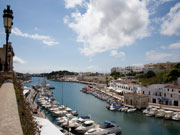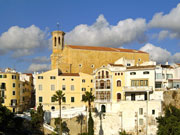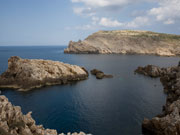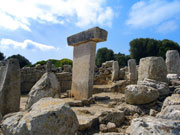THINGS TO SEE AND DO IN MENORCA
Ciutadella

The old town of Ciutadella, wrapped around a wide square beside the pretty small port is a labyrinth of passages, archways and sudden unexpected views. On the western end of the island, with the hills of neighbouring Mallorca clearly visible on the horizon the city was founded by the Carthaginians more than two thousand years ago, and in the 9th century under Arab rule was called Medina Minurqa. It was the island’s capital until the 18th century, when the first British governor Richard Kane, transferred the island’s seat of power to Maó at the other end of the island.
Ciutadella, Menorca. Photo by Nick Haslam Today, Ciutadella with a population of 28,000 is widely regarded as the most beautiful of Menorca’s towns, with a far more Spanish feel than the distinctly Anglo-Saxon Maó. The main square, Plaça des Born is lined with aristocratic palaces of the 18th century and beyond, around the 14th century cathedral (built on the site of the former mosque) narrow arched passageways and courtyards lead into an area which feels more African than Mediterranean.
Close by in the small port lined with fishing boats the ferry leaves each day for Mallorca, and just beyond, a long sandy strip lies between with walled gardens.
Here, on the Dia de Sant Joan– the 23rd June – the most important fiesta of the island takes place each year, with the beautiful black Menorcan horses rearing high amongst the packed crowds beneath the ancient city walls in what is regarded as one of Spain’s most vivid festivals.
Port of Maó

The Port of Maó, a glittering inlet of water extending some 5 kilometres into the heart of Menorca’s capital, is one of the world’s largest natural harbours. With deep sheltered water and a narrow entry from the sea defended by fortresses, in its heyday the docks and wharves were some of the busiest in the Mediterranean, with ships from many countries unloading cargoes beneath the old city walls.
Today, as the island’s capital, Maó has many traces of the British rule on the island during the 18th century, from the Georgian town houses with sash windows and lace curtains to the neo-classical Town.
The old dock area is now a wide corniche by the sea, with restaurants and cafes plying a busy trade when visiting cruise ships dock beneath the high walls of the city. With many charming back streets and squares, Maó retains the relaxed easy going atmosphere of a large friendly country town where everybody seems to know each other.
Bay of Fornells

A spectacular and beautiful inlet on the northern coast, the Bay of Fornells is more than five kilometres long and 2 kilometres wide, with shallow sheltered water providing an ideal location for all kinds of water sports from kayaking to dinghy sailing and windsurfing.
Once frequently raided by Barbary pirates, an 18th century British built watchtower looks down across the narrow entrance, where any ships entering would have been within an easy cannon shot. Today as a safe anchorage from the northerly tramuntana winds, the bay is popular with visiting yachtsmen cruising around the island.
The old fishing village tucked below the headland is tranquil place with excellent restaurants – be sure to try the “caldereta de llagosta”, a delicious succulent lobster stew and one of Menorca’s most famous dishes. With Menorca’s largest marine reserve just off shore the Bay of Fornells is also a Mecca for scuba enthusiasts who come to dive in the clear waters which teem with fish.
Megalithic monuments

Menorca is said to be an open air museum, with one of the largest collection of megalithic monuments in the entire Mediterranean spread throughout the island. These extraordinary standing stones and ancient settlements of the Talaiotic culture, which flourished in the Bronze age are vivid evidence of a sophisticated and well organised society which existed here some 2,000 years BC. There are several distinct forms of the megalithic monuments, from the Taula – ( table in Catalan) – two massive pieces of stone in the form of a high freestanding table or altar, to the Naveta – large burial chambers made of blocks of stone which resemble the hulls of large upturned ships.
There are more than two thousand megalithic monuments on Menorca, with some of the earliest, in the form of burial caves and niches, thought to date back to 2,500 BC.








